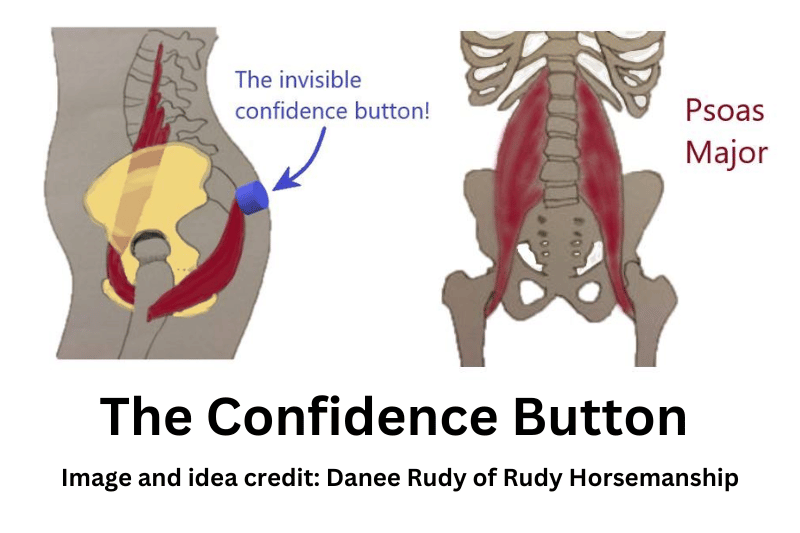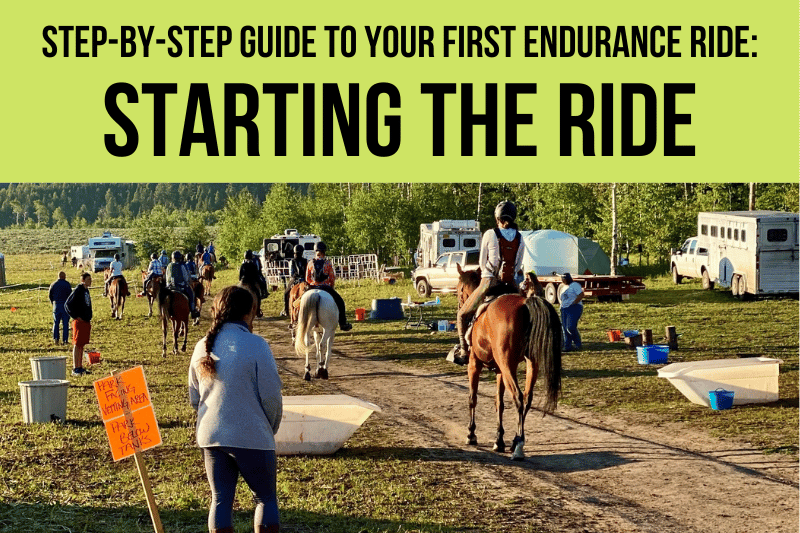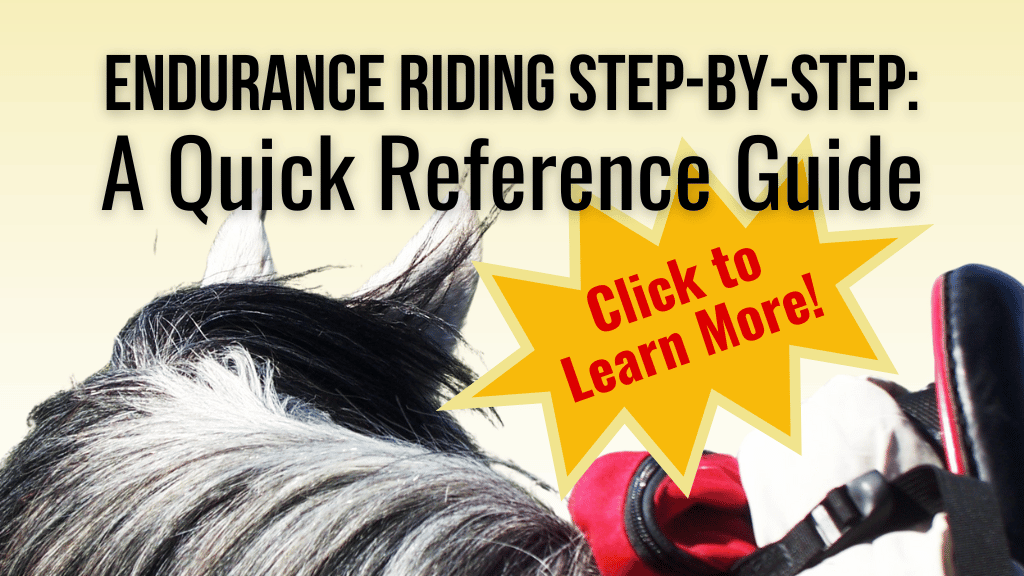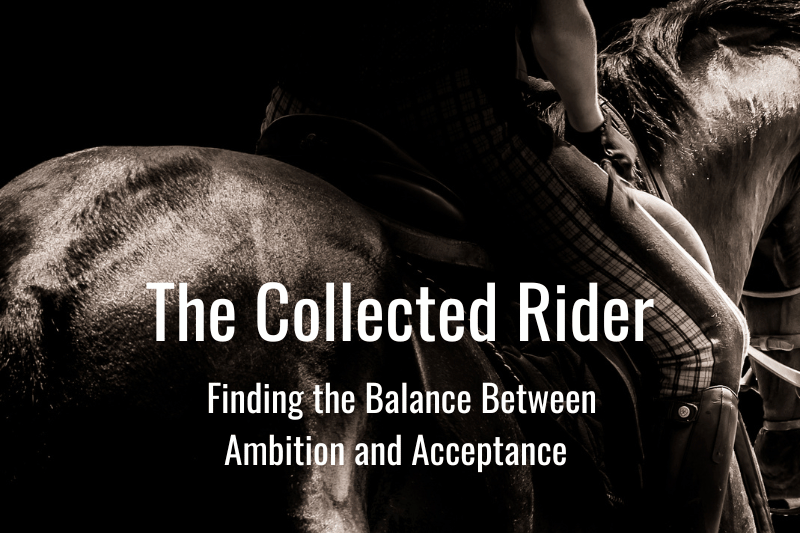It’s finally time! Ride morning is upon you. In just hours, you’ll start down the endurance trail. This article covers everything you need to know about ride morning, from the moment your alarm goes off until your first vet check comes into view.
Did you catch the earlier posts in this series?
Part 1: Step-By-Step Guide: Before Leaving Home
Early Morning Preparation
Most endurance rides start in the morning. It’s common for 50-mile rides to begin around 7:00 a.m. (or earlier in hot weather), while Limited Distance rides often start a bit later, at 8:30 or 9:00.
When to Wake Up
There’s a lot to do on ride morning, so set your alarm for at least 90 minutes before the start. Personally, I hate to feel rushed, so I always get up two hours ahead.
Feed Your Horse, But Not Too Much
If your horse has had free-choice hay all night, he won’t be interested in more of that. However, you can probably tempt him with a small amount of alfalfa or soaked beet pulp.
There is no need to offer a big breakfast. Dr. Susan Garlinghouse points out in Beating the Metabolic Pull that large meals (more than 4-5 pounds at a time) shift fluid from your horse’s plasma to his digestive tract, effectively thickening his blood – not good news for a working endurance horse!
Additionally, Bob Rogers, DVM, advises against feeding any added fats (like oils or rice bran) on ride morning because they slow gut motility.
Electrolyte Your Horse
Many riders administer electrolytes in the morning, even though their horse is likely topped up already. This is done primarily to encourage drinking. Dr. Rogers points out that there may be additional benefit from feeding lite salt or an electrolyte high in potassium (K+) on ride morning, as low potassium levels contribute to elevated heart rates.
Continue Your Ulcer-Prevention Protocol
If you’ve decided to administer omeprazole, dose your horse on his usual schedule. Be sure to use only the preventative dose (1/4 tube of UlcerGard, which is the only over-the-counter, FDA-approved product), as that is the amount permitted under AERC’s drug rules.
You can also buffer stomach acid with alfalfa, Outlast, Neigh-Lox, or kaolin pectin.
Shopping for your horse? You can support this blog (at no extra cost to you) when you use my link to visit SmartPak. I appreciate it so very much!
Take Care of Yourself
Once your horse is munching breakfast, it’s time to focus on your own needs.
Get dressed in the ride clothes you’ve laid out ahead of time. Be sure your Remember-Me Box is handy, because some of the items will likely be used as you get dressed. (Read about the Remember-Me Box in the Step-by-Step Guide: The Evening Before)
Have some breakfast. Even if you don’t feel like eating, it’s important to provide your body with fuel. You’ll need plenty of energy to support your horse through the challenging first loop, and you may be so busy managing him that you’re unable to snack in the saddle.
If your stomach refuses to consider solid food, try a liquid option like UCAN’s protein-plus-energy. The cookies and cream flavor is delicious.
Check out What to Eat on an Endurance Ride for more breakfast and caffeine solutions.
Tack up and Warm Up
About 45 minutes or an hour before the start, saddle your horse. This will give his body time to warm up that cold saddle pad if the weather is chilly.
I always take my horse for a short walk first so he can work off the stiffness from overnight confinement. If he’s blanketed, I leave the blanket on for this stroll, then pull it back to cover his rump while saddling.
Some horses will shiver from a combination of nerves and chill while tacking up. You can help your horse stay comfortable by pulling his blanket back up over the saddle and moving him around some more.
Pro tip: If the ground is wet, don’t put your riding boots on until close to start time. Wear muck boots to keep your feet dry while you tack up.
With everything on but his bridle, tie your horse where he can reach his hay while you make final preparations, like grabbing your helmet and triple-checking that your ride card is in your saddlebag.
Warm Up Your Horse
When you start warming up will depend on your plan for the start itself. Many riders plan to walk the first mile or so out of camp and therefore build their warmup into the ride itself. Others – especially those intending to race – mount about 30 minutes ahead of the start to allow time for loosening up at the walk and trot.
Either way, you’ll want to be sure your horse gets at least 15 minutes of walking before you ask him to trot down the trail. Dr. Garlinghouse emphasizes that senior endurance horses benefit from walking warmups twice that long.
Check In With Management
As start time draws near, the ride manager or a volunteer will hang out near the starting line, likely with a clipboard in hand. She’ll need you to call out your rider number to verify that you are present and ready to ride. Even if you plan to start late (more on that below), you should check in before the official start time.
Starting the Ride
At the prescribed time, the manager will signal that riders are free to head down the trail. The signal may be as simple as a holler that “The trail is open!” or something fun like a song blaring over speakers.
This can be an exciting moment! Most of the horses will be in an elevated emotional state, with their heads and backs lifted. Some will prance sideways. A couple may buck. Many will hit a brisk trot. Others will acquiesce to their riders’ requests to move out a bit more slowly at first.
Depending on your horse’s personality and training level, you may not want to be near the herd when the trail opens. Even many steady-eddy trail partners seem to lose their minds in this situation.
Fortunately, you are not obliged to leave camp as soon as the trail opens. Many riders – especially those on new or green horses – choose to hang back while the faster teams get out of sight. It helps to hide behind a trailer or building so your horse can’t see them leave.
This can be very useful for managing a horse whose emotional level skyrockets at the start. The downside is that it’s a very popular tactic, so even waiting 15 or 20 minutes doesn’t ensure you’ll have the trail to yourself or that nobody will come up behind you.
Bear in mind that every rider’s time starts when the trail opens. You have 12 hours to finish a 50-miler, so if the trail opens at 7:00 a.m., you must complete by 7:00 p.m. to avoid being disqualified.
At some point, you’ll just have to go for it. Heads up, heels down, and press that Confidence Button!

Wait, what’s the Confidence Button? Read about it in this post.
Riding the First Loop
When you get out on the first loop, keep these priorities in mind:
Don’t get caught up in the race. You might be surprised by your own competitiveness in the excitement of ride morning. It’s critical that you fight the urge to go faster than planned.
The common advice to “ride your own ride” refers to the importance of making wise decisions for your own horse, regardless of what others are doing.
Don’t let your horse get caught up in the race. As both prey animals and herd animals, horses do not like to be left behind. It is almost guaranteed that your mount will get swept up in the adrenaline of the start.
Your horse won’t want to be last (that’s where prey animals get eaten!) and he may feel competitive as well. You must find a way to keep him at a sustainable pace, even if that means dismounting to lead him for the first several miles. This is one reason it pays to work on your personal fitness as you prepare for endurance riding.
Watch the ribbons. In the excitement of the start, and perhaps the challenge of managing your horse, it can be easy to blow past a marked turn. Sometimes entire groups of riders go the wrong way, so don’t just follow the crowd. Keep your eyes peeled for trail markers!
Trail Etiquette
In the bustle of fit, over-excited horses at the start of an endurance ride, it’s more important than ever to observe proper trail etiquette to keep everyone safe.
Let other riders pass – If other riders are travelling faster than you, move to the side or off the trail as soon as it’s safe to do so. If necessary, stop and bend or or circle your horse to keep him under control.
Don’t follow too closely – Many horses get nervous about having other horses too close behind them. Some may kick, which is obviously dangerous for everyone. Avoid rushing up on other riders, and keep at least a horse-length between your mount and the horse in front of you.
Preserving space between horses will also let you see the trail and steer clear of obstacles like rocks or holes.
Avoid leapfrogging – Although it’s bound to happen sometimes, do your best to avoid leapfrogging (that is, repeatedly passing and being passed by the same teams), as this tends to upset the horses. If you pass someone, get some distance on them before slowing down.
Signal when slowing or stopping – If you’re leading a group and need to slow or stop your horse, raise your hand in the universal “stop” signal to indicate your intentions. That way, riders behind you won’t run up on your horse’s butt and cause a wreck.
Ask if it’s okay before joining another rider – During the course of a ride, you’re likely to find yourself travelling about the same pace as some other riders. Should you simply join them for the duration? Maybe, but not necessarily!
For various reasons, some riders prefer to ride alone or with a small group of pre-selected buddies. If they indicate they’d rather not have another horse join them, don’t take it personally. It’s almost certainly more about their goals or horse management strategy than about you.
Of course, you should also feel free to kindly express your own preferences when it comes to riding with (or without) companions.
Don’t let your horse guard or splash the water – At water stops, mind your horse’s manners. His behavior shouldn’t intimidate or distract other horses from drinking.
Don’t leave water while other horses are drinking – Some horses will get upset and refuse to drink if they see other horses going on down the trail. If your horse finishes drinking before others, wait for them to finish before riding away.
If you’re just about to leave as other riders approach the water, ask if they’d like you to wait. Etiquette further dictates that, unless agreed otherwise, teams should have the opportunity to leave the water stop in the order in which they arrived.
How Fast Should I Ride?
If you or your horse are new to endurance riding, you’ll want to shoot for a moderate pace. Finishing mid-pack or slower is not only acceptable, but commendable. Racing to place well on a new horse is highly discouraged. In fact, many respected endurance riders never ride to win.
The appropriate pace for your particular event will vary depending on factors like weather and trail conditions. Hot, humid, rocky, or steep rides will typically be ridden more slowly than cooler, flatter rides on good footing.
Generally speaking, you’ll want to settle into the same trot that your horse has become accustomed to during conditioning and cover most of the trail at that speed. Slow down for long or steep climbs and descents. Walk over risky footing like rocks, deep sand, ice, and slick mud. Give your horse plenty of opportunity to drink and munch some grass along the trail.
You may have heard the phrase, “Never hurry, never tarry.” It’s good advice.
Okay, So How Slowly Can I Go?
Of course, you’ll want to be sure you can finish within the time limit for your distance. Here’s how to calculate the slowest pace you can average and still finish on time:
(Total time allowed in minutes – mandatory hold times in minutes) / race distance in miles = average minutes per mile
As an example, let’s do the math for a 50-mile ride. The time limit is 12 hours. The vet has decided there will be two holds totaling 90 minutes of hold time. Just apply the formula:
720 minutes allowed – 90 minutes hold time = 630 minutes to spend on the trail
630 minutes / 50 miles = average pace of 12.6 minutes per mile to finish on time
If you prefer, you can convert pace (minutes per mile) to speed (miles per hour). A 12.6 minute mile pace converts to about 4.75 miles per hour.
While it’s useful to have a minimum pace in the back of your mind, I wouldn’t recommend actually going that slowly.
Why not?
Going the minimum speed leaves no margin for unanticipated delays. For example: You might choose to start late. You might spend a little extra time in the holds. You might have trouble getting your horse over a creek or other obstacle. You might get off trail. At the very least, you’ll certainly make some stops along the way for opening gates or letting your horse drink.
Also, riding slowly means a very long day on the trail, which can actually be harder on your horse than spending fewer hours at a medium pace.
So, How Fast Should I Ride?
Depending on the conditions, an average speed of 6-7 miles per hour (a 10 – 8.5 minute mile pace) is often appropriate. Fifty miles at that speed will take about 7 – 8.5 hours. Add back in the 1.5 hours of hold time from our example above, and you get a total of 8.5 – 10 hours. That gives you a cushion of at least two extra hours in case of delays.
If your eyes have glazed over with all those numbers, don’t worry!
It’s not necessary to be a mathematician or carry a calculator in order to complete your ride on time. Simply follow the age-old advice to “Trot when you can; walk when you have to,” and you’ll be just fine.
Care for Your Horse on the Trail
Your horse’s well-being is your top priority on the endurance trail. As you ride, look for opportunities to keep him healthy and comfortable.
Cooling
Overheating is one of the greatest perils to an endurance horse’s health. You can help your horse stay cool by:
- Sponging water over him (particularly his jugular groove and groin). Note: At shared water troughs, it’s considered poor etiquette to dip sponges, as the sweaty residue may discourage other horses from drinking. Many ride managers place a smaller bucket off to the side for this purpose.
- Slowing down in the shade (to spend more time there) and moving out in the direct sun (to get out of it sooner).
- Slowing down overall. If your horse is a senior, heavily-muscled, overweight, or has a long haircoat, this is even more important.
Eating
Keeping forage in your endurance horse’s stomach as much as possible will encourage gut motility and help prevent gastric ulcers. Your horse will benefit more from regular, small amounts of food throughout the ride than from stuffing himself during holds. You can keep him eating by:
- Training him to grab bites as he moves down the trail
- Stopping periodically to let him eat grass
- Feeding carrots or other treats from your saddlebag. I’ve even seen people carry backpacks stuffed with hay in locations where there’s little natural feed along the trail.
Early in the ride, you may find that your horse is too excited to show interest in food. This doesn’t necessarily mean anything is wrong, so don’t panic. Just do your best to encourage him to settle down and take a few bites.
Drinking
Hydration is key to gut motility and cooling, which are critical to your horse’s safety and performance. It’s important to offer your horse every opportunity to drink from tanks, creeks, and even mud puddles.
To encourage drinking, slow down as you approach water. Take a deep sigh and settle into the saddle, drop your shoulders, and generally convey to your horse that this is a time to stop and relax. He may not drink early in the day, but you should still invite him to consider it.
When he does start drinking, let him have his fill. (That old myth about not giving cold water to a hot horse is exactly that: a myth.)
Dr. Garlinghouse emphasizes that there’s much more to hydration than merely drinking water. I strongly recommend reading Beating the Metabolic Pull Part 1 and Part 2 for additional strategies.
Electrolyting
Depending how long the first loop is, you may wish to give your horse electrolytes on the trail. Dr. Garlinghouse advises small, frequent doses of electrolytes in lieu of large, infrequent doses. This is easier on the horse’s stomach, in addition to his overall metabolic state.
Electrolytes are best administered after your horse has had a good drink. If possible, rinse his mouth with a syringe full of water after dosing him, as the salt may burn his mouth.
Constant Vigilance
Although it’s perfectly fine to chat with a friend and enjoy your ride, you must also continually monitor your horse’s physical and mental state.
Listen and feel for any hint of lameness. Watch for dullness or poor attitude. Note any uncharacteristic behavior or symptoms of pain. When your horse pees, check the color to be sure it’s not brown or red. (If you do see brown or red pee, your horse is tying up. Stop immediately and send for help. Continuing to move risks severe muscle and kidney damage.)
Anytime you have cause for concern, err on the safe side and slow down. Sometimes, just a few minutes of munching green grass is all your horse will need. If he is in real trouble, send word to the nearest vet check with another rider. It’s always better to sacrifice today’s completion in favor of a healthy horse to ride another day.
Relax and Enjoy the Ride
Chances are, if you have prepared and managed your horse well, he’ll handle that first loop in fine form. Relax, take photos, sip water, enjoy the scenery, and soak up this experience with your amazing horse. The miles will fly by, and before you know it, the first vet check will come into view.
You’re not done yet…keep reading the rest of the series!
Too Much to Remember? You Need the Quick Reference Guide!
The entire Endurance Riding Step-by-Step series is now available in a consolidated format for easy reference beyond the reach of wi-fi or cell service. Just download it to your phone and use the clickable Table of Contents for speedy access to the information you need, when you need it. Click to learn more!
You might also like
This post includes affiliate links, and I may earn a small commission (at no extra cost to you) when you purchase through these links. I only recommend products and services I think are helpful and useful. Thanks for helping me offset the cost of maintaining this blog as a free resource!





I have only finished one LD ride. But it was the most amazing experience! Unfortunately, I did not take EVERYONE’S advice to “ride at your own pace”. If I could do everything over I would. No serious injuries occurred, just a little bit of regret. Going forward, I will know better! Thank you for this blog, I truly enjoyed the read!
Thanks for sharing your story! I don’t think most of us realize, until we’re in the situation, how very difficult it is to avoid getting caught up in the race and going too fast. I hope your next ride is even more amazing than the first! 🙂